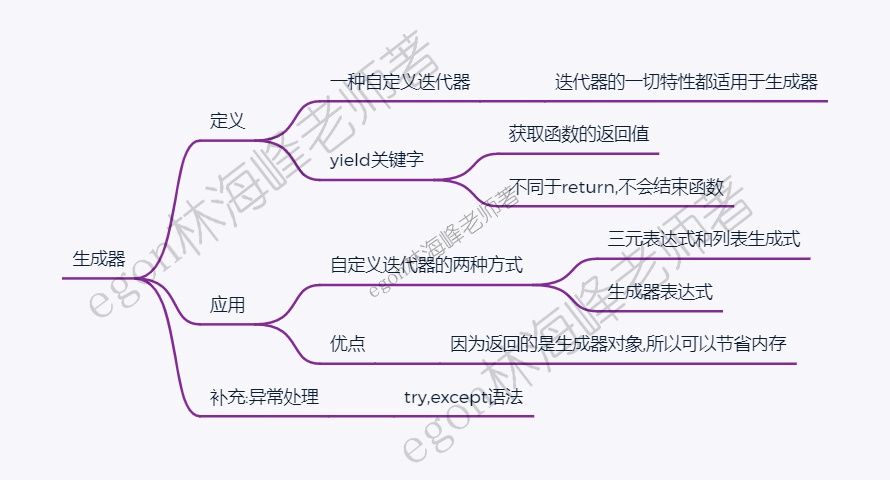若函数体包含yield关键字,再调用函数,并不会执行函数体代码,得到的返回值即生成器对象
| >>> def my_range(start,stop,step=1): |
| ... print('start...') |
| ... while start < stop: |
| ... yield start |
| ... start+=step |
| ... print('end...') |
| ... |
| >>> g=my_range(0,3) |
| >>> g |
| <generator object my_range at 0x104105678> |
生成器内置有__iter__和__next__方法,所以生成器本身就是一个迭代器
| >>> g.__iter__ |
| <method-wrapper '__iter__' of generator object at 0x1037d2af0> |
| >>> g.__next__ |
| <method-wrapper '__next__' of generator object at 0x1037d2af0> |
插图:恶搞图50
因而我们可以用next(生成器)触发生成器所对应函数的执行,
| >>> next(g) |
| start... |
| 0 |
| >>> next(g) |
| 1 |
| >>> next(g) |
| 2 |
| >>> next(g) |
| end... |
| Traceback (most recent call last): |
| File "<stdin>", line 1, in <module> |
| StopIteration |
既然生成器对象属于迭代器,那么必然可以使用for循环迭代,如下:
| >>> for i in countdown(3): |
| ... print(i) |
| ... |
| countdown start |
| 3 |
| 2 |
| 1 |
| Done! |
有了yield关键字,我们就有了一种自定义迭代器的实现方式。yield可以用于返回值,但不同于return,函数一旦遇到return就结束了,而yield可以保存函数的运行状态挂起函数,用来返回多次值
在函数内可以采用表达式形式的yield
| >>> def eater(): |
| ... print('Ready to eat') |
| ... while True: |
| ... food=yield |
| ... print('get the food: %s, and start to eat' %food) |
| ... |
可以拿到函数的生成器对象持续为函数体send值,如下
| >>> g=eater() |
| >>> g |
| <generator object eater at 0x101b6e2b0> |
| >>> next(e) |
| Ready to eat |
| >>> g.send('包子') |
| get the food: 包子, and start to eat |
| >>> g.send('鸡腿') |
| get the food: 鸡腿, and start to eat |
针对表达式形式的yield,生成器对象必须事先被初始化一次,让函数挂起在food=yield的位置,等待调用g.send()方法为函数体传值,g.send(None)等同于next(g)。
我们可以编写装饰器来完成为所有表达式形式yield对应生成器的初始化操作,如下
| def init(func): |
| def wrapper(*args,**kwargs): |
| g=func(*args,**kwargs) |
| next(g) |
| return g |
| return wrapper |
| |
| @init |
| def eater(): |
| print('Ready to eat') |
| while True: |
| food=yield |
| print('get the food: %s, and start to eat' %food) |
表达式形式的yield也可以用于返回多次值,即变量名=yield 值的形式,如下
| >>> def eater(): |
| ... print('Ready to eat') |
| ... food_list=[] |
| ... while True: |
| ... food=yield food_list |
| ... food_list.append(food) |
| ... |
| >>> e=eater() |
| >>> next(e) |
| Ready to eat |
| [] |
| >>> e.send('蒸羊羔') |
| ['蒸羊羔'] |
| >>> e.send('蒸熊掌') |
| ['蒸羊羔', '蒸熊掌'] |
| >>> e.send('蒸鹿尾儿') |
| ['蒸羊羔', '蒸熊掌', '蒸鹿尾儿'] |
三元表达式是python为我们提供的一种简化代码的解决方案,语法如下
| res = 条件成立时返回的值 if 条件 else 条件不成立时返回的值 |
针对下述场景
| def max2(x,y): |
| if x > y: |
| return x |
| else: |
| return y |
| |
| res = max2(1,2) |
用三元表达式可以一行解决
| x=1 |
| y=2 |
| res = x if x > y else y |
列表生成式是python为我们提供的一种简化代码的解决方案,用来快速生成列表,语法如下
| [expression for item1 in iterable1 if condition1 |
| for item2 in iterable2 if condition2 |
| ... |
| for itemN in iterableN if conditionN |
| ] |
| |
| |
| res=[] |
| for item1 in iterable1: |
| if condition1: |
| for item2 in iterable2: |
| if condition2 |
| ... |
| for itemN in iterableN: |
| if conditionN: |
| res.append(expression) |
针对下述场景
| egg_list=[] |
| for i in range(10): |
| egg_list.append('鸡蛋%s' %i) |
用列表生成式可以一行解决
| egg_list=['鸡蛋%s' %i for i in range(10)] |
创建一个生成器对象有两种方式,一种是调用带yield关键字的函数,另一种就是生成器表达式,与列表生成式的语法格式相同,只需要将[]换成(),即:
| (expression for item in iterable if condition) |
对比列表生成式返回的是一个列表,生成器表达式返回的是一个生成器对象
| >>> [x*x for x in range(3)] |
| [0, 1, 4] |
| >>> g=(x*x for x in range(3)) |
| >>> g |
| <generator object <genexpr> at 0x101be0ba0> |
对比列表生成式,生成器表达式的优点自然是节省内存(一次只产生一个值在内存中)
| >>> next(g) |
| 0 |
| >>> next(g) |
| 1 |
| >>> next(g) |
| 4 |
| >>> next(g) |
如果我们要读取一个大文件的字节数,应该基于生成器表达式的方式完成
| with open('db.txt','rb') as f: |
| nums=(len(line) for line in f) |
| total_size=sum(nums) |










